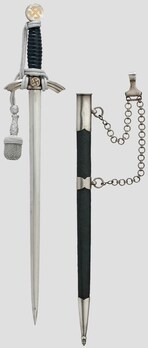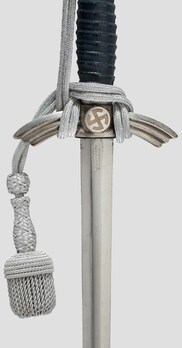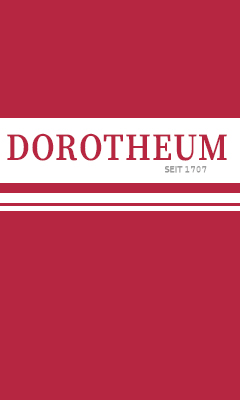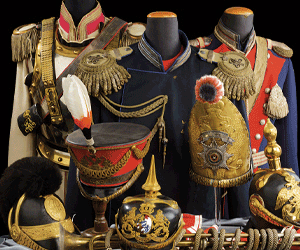DLV Officer's Dagger
SKU: 55.GOR.04.01.001
Estimated market value:



Estimated market value:
Attributes
History
On March 25, 1933 the DLV (Deutscher Luftsportverband = German Air Sports Association) was created as a civilian sports organisation, the umbrella organisation of all air-related sports. However, from the very beginning, the DLV was used to secretly train its members for future roles in the newly emerging Luftwaffe, a breach of the terms of the Versailles Treaty.
The organisation should not be confused with the Deutscher Luftfahrtverband (also abbreviated DLV), which was formed in 1902, but disbanded in favour of the new DLV under Third Reich rule.
The DLV was split into two groups, the civilian section and the secret military section, known as the “Fliegerschaft” (air crew). The organisation eventually became obsolete after the official unveiling of the Luftwaffe in 1935, and it was disbanded and replaced by the National Socialist Flyers Corps (NSFK or Nationalsozialistisches Fliegerkorps) in 1937.
The DLV edged weapons were only issued from 1934 to 1936, due to the introduction of edged weapons for the Luftwaffe in 1935. From 1935 to 1937, a transitional version of the DLV Officer’s dagger was manufactured and issued alongside the Luftwaffe dagger.
The transitional DLV Officer’s dagger dates from 1935 to 1937, and it is almost identical to the DLV Officer’s dagger. The main difference between the two daggers is that the transitional dagger blade is shorter than the DLV Officer's dagger blade. The transitional dagger blade was cut down in size to match the new Luftwaffe Officer’s dagger regulations.
The DLV Officer’s dagger, also known as the Flyer’s Dagger, was instituted in 1934 by the DLV’s President Bruno Loerzer. The dagger was worn by Officers when they were dressed in their DLV uniform. That same year, a knife was introduced for wear by non-Officer ranks of DLV personnel, it is known as the Flyer’s Knife (Fliegermesser).
The DLV dagger is known for its length and thin blade.
This dagger’s pommel is a silver-coloured circular medallion with a gold-coloured sunwheel swastika on the obverse and reverse surfaces. The early daggers feature swastikas that were inlaid flush with the medallion. Daggers that were manufactured later have sunwheel swastikas that were produced using less time-consuming methods, such as incorporating the swastikas as a raised section of the medallion, or engraving the swastikas. The pommel and sunwheel swastikas are generally composed of silvered or gilt brass, respectively.
The base of the grip is made from wood, and then wrapped with brass wire in a spiral design to give the grip a segmented appearance. The wood and wire is covered in a thin layer of blue Moroccan leather.
The crossguard is made up of a centre block and two extending wings/arms. The obverse and reverse centre blocks may be rectangular or circular, and both sides feature a sunwheel swastika. The extending wings are composed of three long, segmented ovals that are curved downwards. The shape of the centre block and the extent of the wings’ curvature differs per manufacturer.
These DLV dagger blades are double-edged and they are generally composed of nickel-plated steel; although there are also examples of blades manufactured from polished steel. These blades are approximately 385mm long; the length varies between manufacturers.
The base of the scabbard is made from cardboard composite, and just like the grip, the exterior is covered in a thin strip of blue Moroccan leather. The body of the scabbard also features three sheet nickel fittings. The tops two fittings have attached carrying rings which connect with the dagger hanger, and the bottom fitting/chape resembles a rattlesnake tail. The interior of the scabbard includes three spring-tension runners to hold the blade in place.
The dagger hanger is composed of two chain segments, with 9 links on the top chain and 14 links on the bottom chain. The upper and lower chain segments are linked by a clip. The chain links and snap clip are composed of nickel. The reverse of the early snap clips should feature the patent stamp, containing the inscription "D.R.G.M." and the patent number below the letters. The snap clips on later versions may not be stamped.
There may be additional stamps on the scabbard throat. For example, markings on the crossguard wing-ends or scabbard throat may be associated with the dagger’s owner or other manufacturers.
This dagger may also be known as the “55” because its total length, including the scabbard, is approximately 55cm.

Versions
$3,500 USD
385mm (blade); 550mm (including scabbard)
This item is scarce.


Comments
Sign in to comment and reply.


Scroll Top